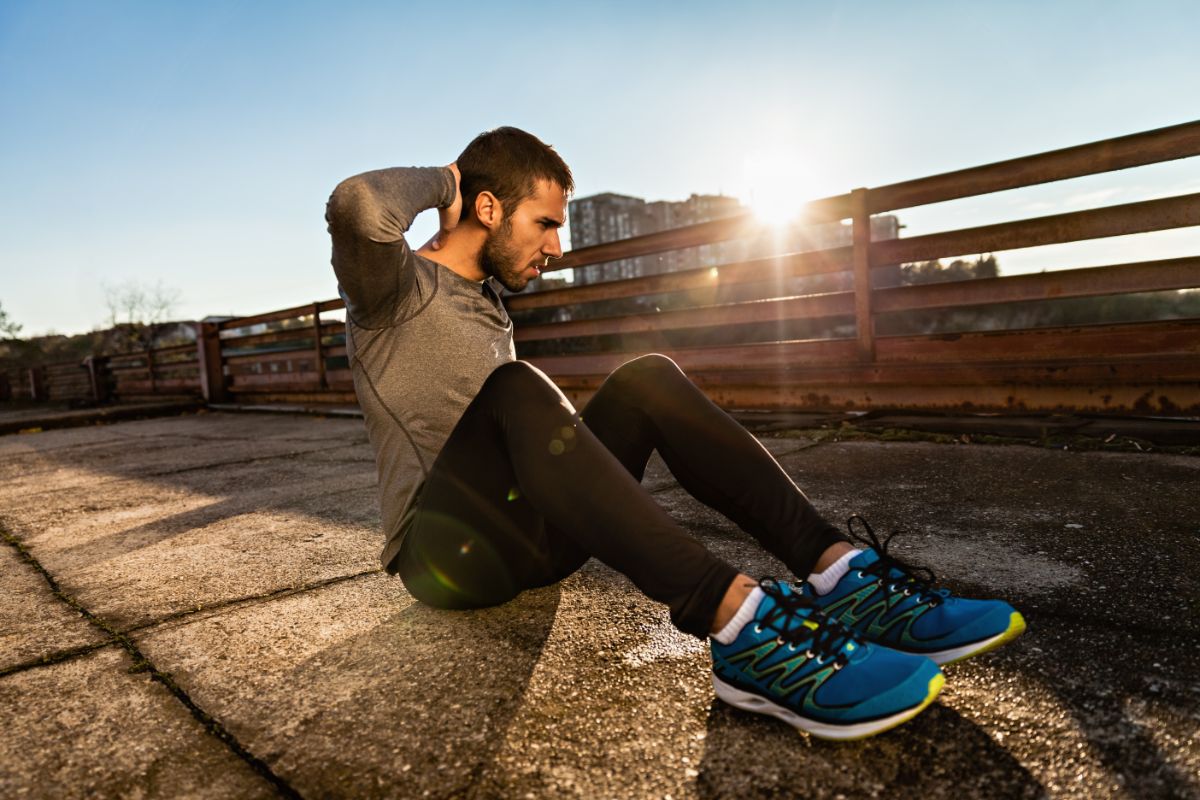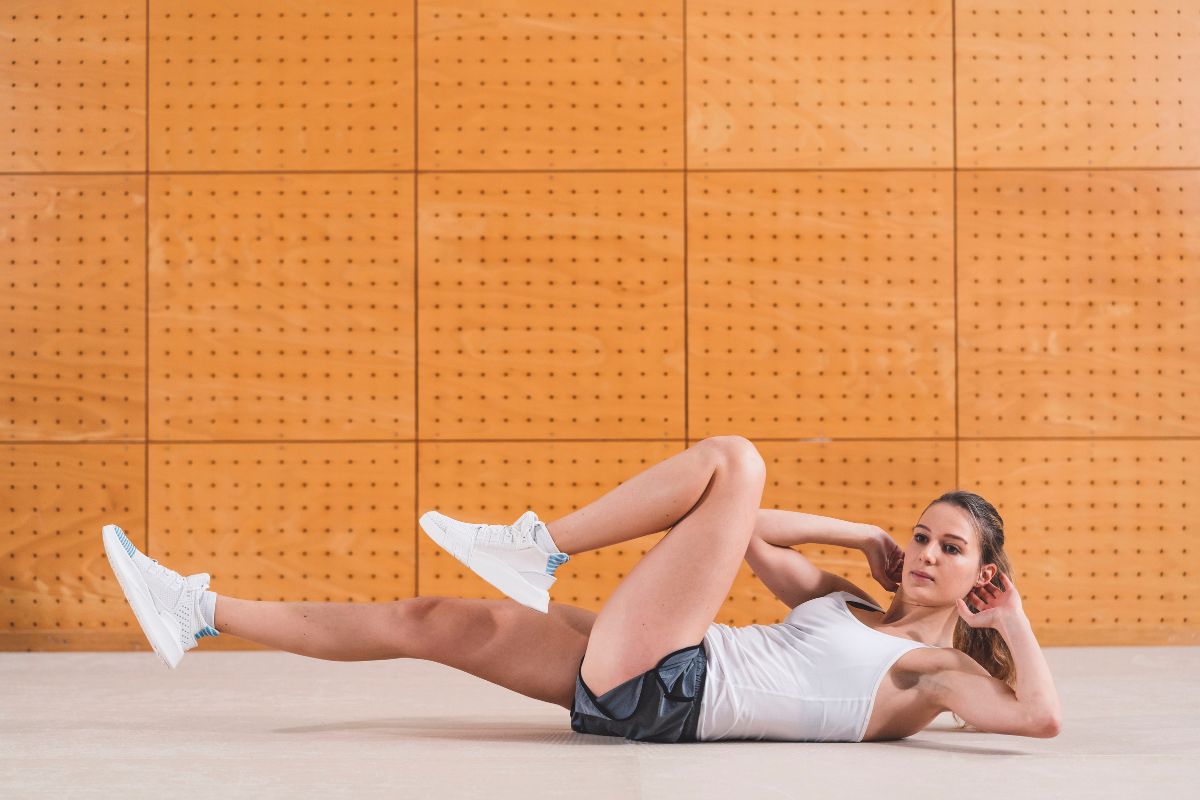The sit-up is a common exercise for strengthening your abdominal muscles without the use of any equipment.


When you do one, you move from a lying to an upright position by directing the torso towards your thighs.
This specifically activates the rectus abdominis muscle but there are other muscles that a sit-up can benefit which we will talk about in this article.
What Muscles Are Engaged During Sit-Ups?
Additional muscles can help with sit-ups depending on your technique. Neck flexors, chest muscles, and even shoulder extensors can all contract to help lift your torso off the ground.
Cross your arms over your chest instead of placing your hands behind your ears to reduce the use of your chest and shoulders. Maintain a relaxed neck throughout the movement.
Rectus Abdominis
The rectus abdominis is an abdominal muscle wall that connects to the lower rib cage and hips. The six-pack effect is achieved by building it up so that it presses against its crossing tendons.
Its role is to bring the rib cage and pelvis closer together.
To protect the spine, the sit-up should be done with the spine slightly rounded at all times. The rectus abdominis is worked by this contraction.
Internal And External Obliques
The external obliques connect to the rib cage and pelvis, but only on one side of the rectus abdominis.
The external obliques are the most important muscles responsible for rotating the body back and forth as well as rotating the rib cage from side to side.
They help the rectus abdominis crunch the rib cage straight toward the pelvis when contracted at the same time.
Iliopsoas
This is where the sit-up distinguishes itself from the crunch. The iliopsoas connects to the lower spine, hips, and the upper front of the femur.
Their purpose is to help the body bend at the hips. In most cases, this means lifting the thigh in the direction of the torso, but in the case of sit-ups, it means lifting the body toward the thighs.
They are very weak in comparison to the gluteus maximus, which are some of the strongest and largest in the body. This is one good reason to do sit-ups with them.
Rectus Femoris
This is a quadricep head in which there are four in total, which are the big muscles in the thigh.
Every one of these quadriceps has heads that join onto the knee cap known as the patella. The primary function of these parts is to extend the leg.
The rectus femoris crosses the hips and connects to the pelvis while the other quadriceps heads join onto the upper femur.
During a sit-up, it assists the iliopsoas in moving the hips and bringing the torso in the direction of the thighs.
Benefits Of Sit-Ups
Builds Muscle
Sit-ups teach your abdominal muscles to contract against resistance and lift weights for extended periods of time. It is primarily a muscular endurance exercise.
Muscular endurance differs from strength training in that it focuses on stability and support rather than power. Slow-twitch fibers are found in muscles associated with endurance activities.
Slow-twitch muscles have higher levels of oxygen-binding proteins and greater access to blood supply than fast-twitch muscles.
Slow-twitch muscle training will increase your stamina, allowing you to push your body for longer periods of time.
However, it is impossible to completely separate strength training from endurance training. Sit-ups also require the use of fast-twitch muscles, which means a more comprehensive workout for you.
Improves Posture
Sit-ups engage your core, which will benefit you in your daily life. Standard sit-ups will aid in the improvement of core strength and a good posture.
The muscles around the spine must be strong and balanced in order to give support to the body — this is referred to as a neutral spine position. Proper posture is not only appealing but is also important for overall health.
Engages Multiple Areas
Hip flexors are notoriously weak when compared to their antagonist muscle, the gluteus maximus.
They do, however, play an important role in stabilizing the pelvis and spine and protecting your lower back, so strengthening them with sit-ups is a good idea.
Burns Calories
Sit-ups burn more calories than comparable exercises as they engage so many other parts of your body. The number of calories varies depending on age, gender, weight, and workout intensity.


Types Of Sit-Ups
Standard
Lie on your back with your knees bent, your legs open, and the soles of your feet on the floor.
Set your feet apart from your buttocks so that your fingertips meet your ankles.
Engage your abdomen and with control, sit up by gradually raising your upper body off of the floor and bending your hips.
Pull your shoulder blades down and back to keep your upper back straight.
To reduce strain on the hip flexor, a slight flexion of the lower back is perfectly normal.
Engage your abdomen and sit up with control by gradually lifting your upper body from the floor and bending your hips.
Pull your shoulder blades down and back to keep your upper back straight.
To reduce strain on the hip flexor, a slight flexion of the lower back is perfectly normal.
Lower yourself bit by bit to the floor while inhaling, keeping your shoulder blades in the air.
Butterfly
Lie on your back and place the soles of your feet together.
Start off with your back flat against the floor with the soles of your feet together.
Put your knees in the position that they would normally be in for a standard sit-up, but then let them fall to the side with the feet still touching one another.
Extend your arms over your head and use your abdominal muscles to straighten up and touch your feet.
Go back to the beginning position while still maintaining control.
You can make this sit-up more cardio-orientated by doing it faster.
With Resistance Band
This variation is ideal for beginners who want to ease into sit-ups.
Put a resistance band around your feet, holding both ends with your hands.
It will be easier to sit up due to the resistance band’s force.
Instead of bending your legs, stretch them straight on the floor for a higher intensity.
With Dumbbells
Sit-ups with added weight are a good option for those who are wanting to try something harder.
Engage your stomach and hold a dumbbell in each hand, or a kettlebell in front of your chest.
When you reach the top, you can punch the dumbbells into the air or raise them up over your head towards the sky.
Both variations increase the movement’s intensity.
With Twist
Begin by lying on the mat with your legs hip-width apart.
Either cross your arms in front of your chest, clasp your hands in a pistol shape at your abdomen, or bring your fingers to your temples.
Raise your shoulder blades off the floor, tense your abdomen, and stand up straight, twisting to one side as you do so.
Touch your opposite knee with your elbow or your outstretched arms along the side of your opposite leg.
Return to the floor and repeat on the opposite side. This version focuses on the lateral abdominal muscles.
Summary
The sit-up is one of the most popular exercises out there. It engages a lot of different muscles including the Rectus Abdominis, Internal and External Obliques, Iliopsoas, and the Rectus Femoris.
Sit-ups can also be done in various ways which keep it exciting and will also encourage new muscle build and strength.
Sit-ups also help to improve your posture if you do them properly and not only does this look better but will also improve your overall health.
- How To Start HIIT Workouts [Beginner’s Guide] - May 18, 2023
- How To Sneak A Workout In While Taking Care Of Your Baby - March 17, 2023
- How To Build Your Chest With Dumbbells [Guide] - February 9, 2023








